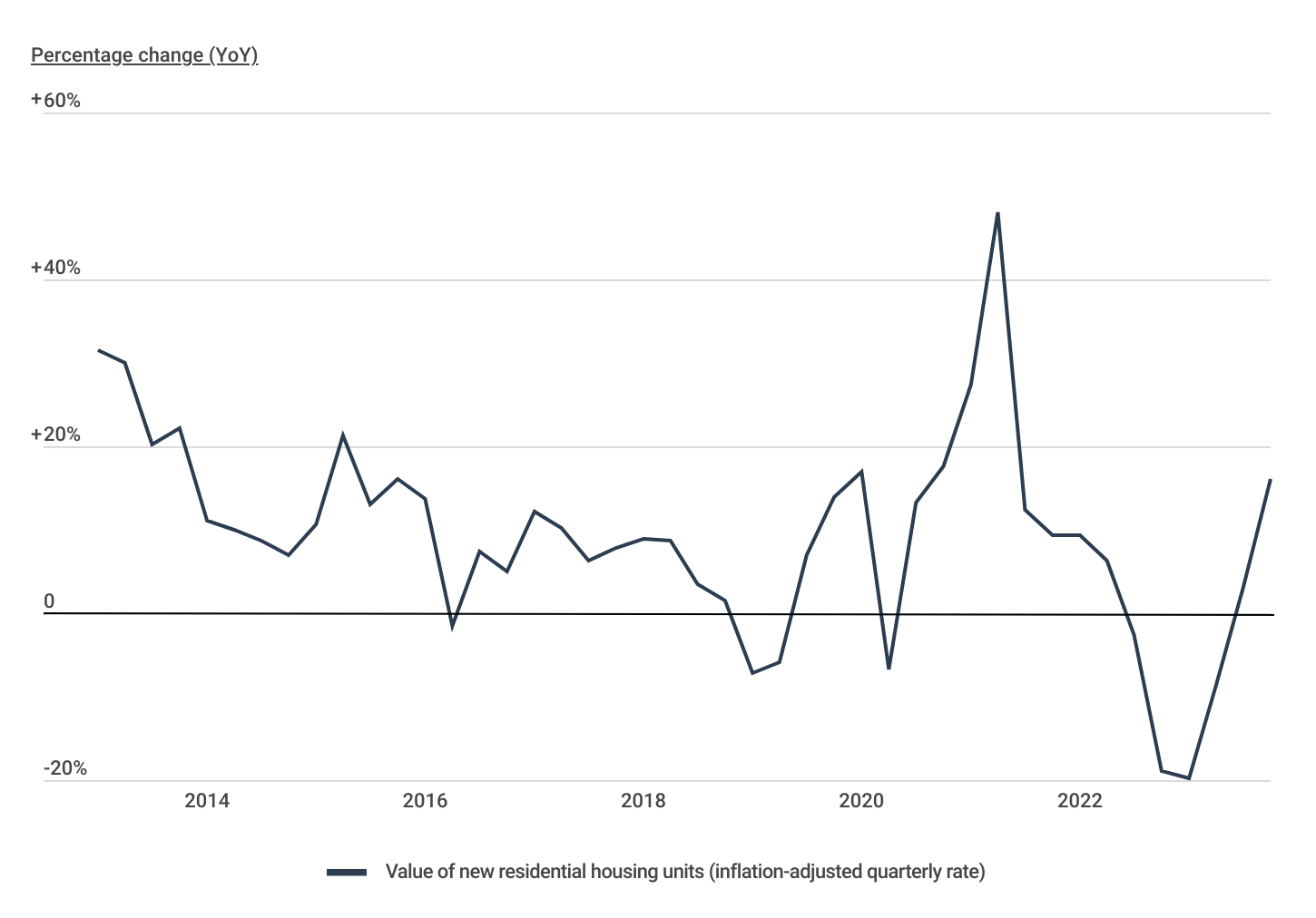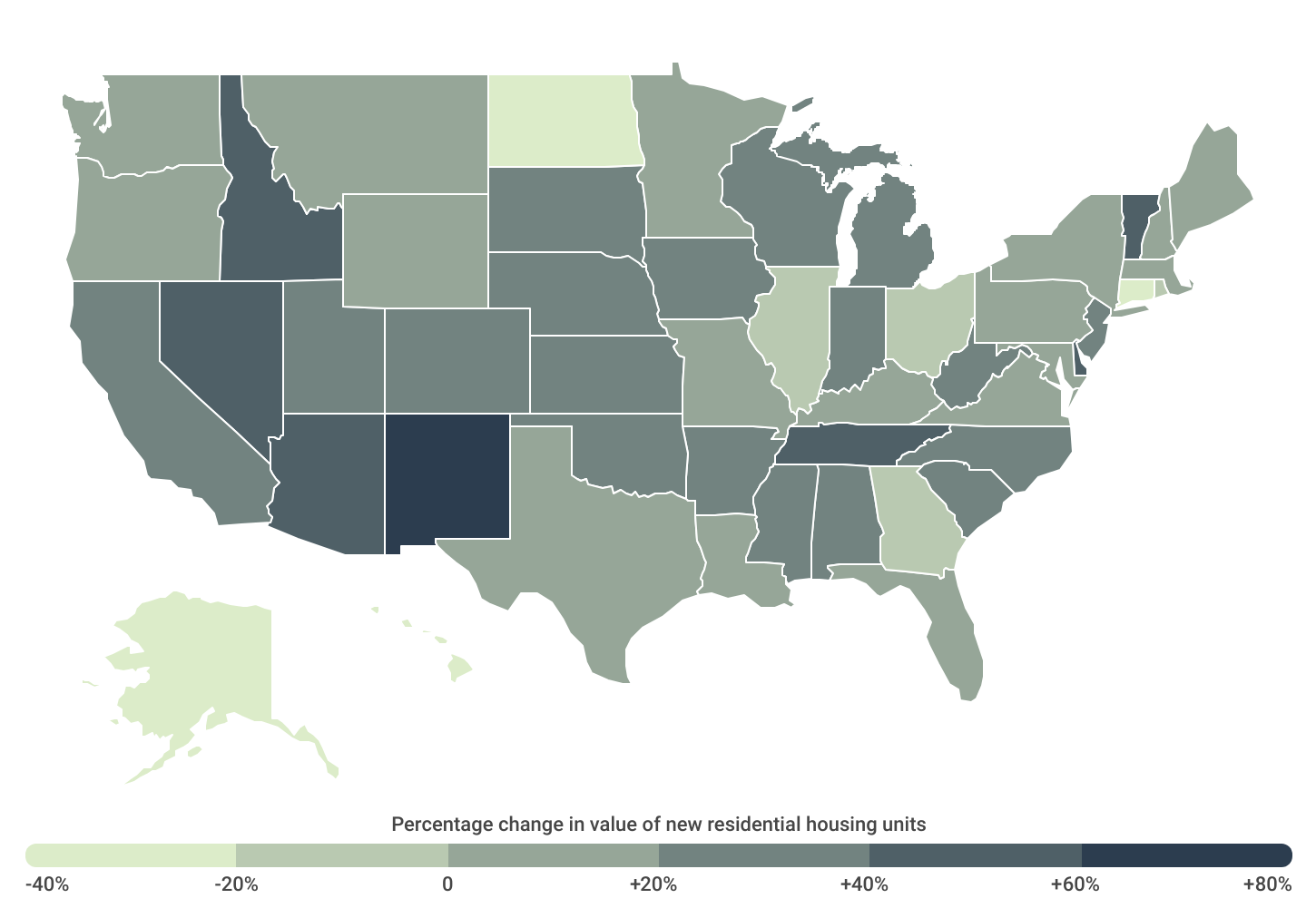Cities With the Biggest Year-Over-Year Increase in Residential Construction
Note: This is the most recent release of our Cities With the Biggest Year-Over-Year Increase in Residential Construction study. To see data from prior years, please visit the Full Results section below.
The U.S. housing market, which cooled off in 2023 after a pandemic boom, is showing signs of a revival. The median home sale price grew 5.3% year-over-year in March 2024, and homes are selling more quickly—the share of homes sold in under two weeks is up 1.3 percentage points during the same period. This uptick in activity suggests a potential return to growth, incentivizing builders to seek permits for new construction, which could help alleviate the inventory shortage that has plagued the country for years.
30-Year Fixed Mortgage Rates
Mortgage interest rates remain elevated, making borrowing more expensive than pre-COVID

Over the past few years, interest rates have stood out as a key determinant affecting both buyer and builder confidence in the housing market. As the Federal Reserve rapidly increased rates during 2022 and 2023 to curb inflation, average 30-year fixed mortgage rates climbed to levels not seen in over two decades, reaching a peak of 7.79% in October 2023. Consequently, this period witnessed notable declines in transaction volume, prices, and builder confidence. However, since the peak in fall 2023, mortgage rates have gradually declined, contributing to a modest resurgence of buyer and builder activity in the market.
FOR CONTRACTORS
If you use your personal vehicle for work, you should have a commercial vehicle insurance policy. Some insurers even offer specialty truck insurance policies in certain scenarios.
Changes in New Residential Home Construction
Despite persistently high interest rates, home construction permits are showing signs of growth

These trends are reflected in residential construction activity—specifically the total value of new housing projects authorized by building permits. After increasing by as much as 48% year-over-year in Q2 2021, residential construction projects began slowing down, bottoming out at a 20% year-over-year decline in early 2023. But, according to the National Association of Home Builders, the recent combination of pent-up demand, moderating interest rates, and a persistent shortage of inventory has helped accelerate building activity.
Residential housing construction ended 2023 on a high note, with authorized permit value increasing 3.1% in Q3 and 16% in Q4 from the same periods the year prior. And with the Fed projected to cut rates three times by the end of the year, sustained construction growth may be in store.
Geographical Differences in New Residential Home Construction
Southwestern states experienced the biggest increase in home construction

Some locations, however, are investing more in new residential construction than others compared to the same time last year. Areas in the Desert Southwest—who typically have more affordable home prices than some neighboring areas—saw the biggest increase in residential housing permit value from Q4 2023 to the year prior. New Mexico led all states with a 75.9% permit value increase, while Nevada and Arizona were the only other states to see increases greater than 50%. The same holds true at the metropolitan level where Las Vegas, NV led all large metros with a 106.9% increase year-over-year, and Santa Fe, NM led all small metros with a staggering 566.2% increase.
Below is a breakdown of changes in home construction for over 370 metros and all 50 states. The analysis was conducted by Construction Coverage using data from the U.S. Census Bureau. For more detailed information, refer to the methodology section.
Large Metros With the Biggest Change in Home Construction
| Top Metros | Change* |
|---|---|
| 1. Las Vegas-Henderson-North Las Vegas, NV | 106.9% |
| 2. San Diego-Chula Vista-Carlsbad, CA | 80.9% |
| 3. Indianapolis-Carmel-Greenwood, IN | 80.0% |
| 4. Denver-Aurora-Centennial, CO | 75.8% |
| 5. Memphis, TN-MS-AR | 66.3% |
| 6. Tucson, AZ | 49.5% |
| 7. Nashville-Davidson–Murfreesboro–Franklin, TN | 44.4% |
| 8. Birmingham, AL | 42.5% |
| 9. Riverside-San Bernardino-Ontario, CA | 37.7% |
| 10. Sacramento-Roseville-Folsom, CA | 37.5% |
| 11. Phoenix-Mesa-Chandler, AZ | 36.2% |
| 12. Pittsburgh, PA | 34.7% |
| 13. Richmond, VA | 33.6% |
| 14. Tulsa, OK | 33.4% |
| 15. Milwaukee-Waukesha, WI | 31.4% |
| Bottom Metros | Change* |
|---|---|
| 1. Buffalo-Cheektowaga, NY | -39.8% |
| 2. Rochester, NY | -22.8% |
| 3. Austin-Round Rock-San Marcos, TX | -20.3% |
| 4. Washington-Arlington-Alexandria, DC-VA-MD-WV | -16.0% |
| 5. Atlanta-Sandy Springs-Roswell, GA | -11.0% |
| 6. Boston-Cambridge-Newton, MA-NH | -9.2% |
| 7. Minneapolis-St. Paul-Bloomington, MN-WI | -9.1% |
| 8. Cincinnati, OH-KY-IN | -7.9% |
| 9. Seattle-Tacoma-Bellevue, WA | -7.2% |
| 10. Baltimore-Columbia-Towson, MD | -5.0% |
| 11. Orlando-Kissimmee-Sanford, FL | -4.9% |
| 12. Chicago-Naperville-Elgin, IL-IN | -3.4% |
| 13. San Francisco-Oakland-Fremont, CA | -2.9% |
| 14. Jacksonville, FL | -2.1% |
| 15. New York-Newark-Jersey City, NY-NJ | 0.1% |
FOR CONSTRUCTION BUSINESSES
To make sure your workers are protected in the case of a workplace accident, you’ll want a workers’ compensation insurance policy that fits your budget and covers potential employee medical expenses, loss of income, and more. These are the best workers comp insurance providers on the market.
Midsize Metros With the Biggest Change in Home Construction
| Top Metros | Change* |
|---|---|
| 1. Flint, MI | 293.4% |
| 2. Oxnard-Thousand Oaks-Ventura, CA | 209.7% |
| 3. Trenton-Princeton, NJ | 195.3% |
| 4. Bakersfield-Delano, CA | 148.6% |
| 5. Albuquerque, NM | 147.3% |
| 6. Lancaster, PA | 120.5% |
| 7. Springfield, MA | 117.9% |
| 8. Knoxville, TN | 108.3% |
| 9. Fayetteville, NC | 104.8% |
| 10. Brownsville-Harlingen, TX | 101.3% |
| 11. Peoria, IL | 77.2% |
| 12. Little Rock-North Little Rock-Conway, AR | 76.2% |
| 13. Modesto, CA | 75.2% |
| 14. Greensboro-High Point, NC | 71.8% |
| 15. Montgomery, AL | 67.4% |
| Bottom Metros | Change* |
|---|---|
| 1. Akron, OH | -77.8% |
| 2. Anchorage, AK | -61.4% |
| 3. Urban Honolulu, HI | -54.5% |
| 4. Visalia, CA | -41.9% |
| 5. Santa Maria-Santa Barbara, CA | -37.2% |
| 6. Toledo, OH | -24.4% |
| 7. Worcester, MA | -23.6% |
| 8. Eugene-Springfield, OR | -14.1% |
| 9. Portland-South Portland, ME | -11.0% |
| 10. Columbia, SC | -9.0% |
| 11. Allentown-Bethlehem-Easton, PA-NJ | -8.1% |
| 12. York-Hanover, PA | -7.5% |
| 13. New Orleans-Metairie, LA | -2.5% |
| 14. Atlantic City-Hammonton, NJ | -0.6% |
| 15. Hickory-Lenoir-Morganton, NC | -0.5% |
Small Metros With the Biggest Change in Home Construction
| Top Metros | Change* |
|---|---|
| 1. Santa Fe, NM | 566.2% |
| 2. Idaho Falls, ID | 450.9% |
| 3. Wausau, WI | 398.2% |
| 4. Muncie, IN | 384.8% |
| 5. Helena, MT | 226.5% |
| 6. Warner Robins, GA | 206.4% |
| 7. Corvallis, OR | 169.3% |
| 8. Lake Charles, LA | 147.7% |
| 9. Lewiston-Auburn, ME | 136.7% |
| 10. Greenville, NC | 131.9% |
| 11. Sheboygan, WI | 128.4% |
| 12. Kokomo, IN | 126.8% |
| 13. Bremerton-Silverdale-Port Orchard, WA | 122.7% |
| 14. Lynchburg, VA | 121.6% |
| 15. Rockford, IL | 120.7% |
| Bottom Metros | Change* |
|---|---|
| 1. Anniston-Oxford, AL | -80.3% |
| 2. Minot, ND | -77.8% |
| 3. State College, PA | -69.3% |
| 4. Grand Junction, CO | -69.2% |
| 5. Merced, CA | -68.7% |
| 6. Kankakee, IL | -61.8% |
| 7. Lebanon, PA | -57.7% |
| 8. Boulder, CO | -54.0% |
| 9. Kenosha, WI | -52.8% |
| 10. Columbus, GA-AL | -47.3% |
| 11. Athens-Clarke County, GA | -45.2% |
| 12. Altoona, PA | -44.8% |
| 13. Paducah, KY-IL | -43.0% |
| 14. Bellingham, WA | -42.8% |
| 15. Bismarck, ND | -42.3% |
States With the Biggest Change in Home Construction
| Top States | Change* |
|---|---|
| 1. New Mexico | 75.9% |
| 2. Nevada | 59.4% |
| 3. Arizona | 54.4% |
| 4. Delaware | 46.0% |
| 5. Tennessee | 43.8% |
| 6. Vermont | 42.4% |
| 7. Idaho | 40.6% |
| 8. Alabama | 39.0% |
| 9. West Virginia | 36.5% |
| 10. South Dakota | 34.2% |
| 11. Indiana | 34.0% |
| 12. Utah | 32.8% |
| 13. Kansas | 31.0% |
| 14. New Jersey | 28.0% |
| 15. Colorado | 25.8% |
| Bottom States | Change* |
|---|---|
| 1. North Dakota | -43.6% |
| 2. Alaska | -41.5% |
| 3. Hawaii | -28.6% |
| 4. Connecticut | -20.4% |
| 5. Illinois | -13.1% |
| 6. Rhode Island | -2.9% |
| 7. Georgia | -1.5% |
| 8. Ohio | -0.9% |
| 9. Minnesota | 1.4% |
| 10. Wyoming | 3.7% |
| 11. Montana | 5.2% |
| 12. Louisiana | 8.4% |
| 13. Oregon | 9.0% |
| 14. Washington | 9.8% |
| 15. Massachusetts | 10.1% |
*Percentage change in value of new residential housing units
Methodology
The data used in this analysis is from the U.S. Census Bureau’s Building Permits Survey. To find the locations with the biggest increase in home construction, researchers at Construction Coverage calculated the percentage change in value of new residential housing units authorized by permit-issuing places from Q4 2022 to Q4 2023. In the event of a tie, the location with the bigger increase in total value of new residential housing units was ranked higher. The researchers also calculated the percentage change and total change in newly authorized residential housing units. For relevance, only metropolitan areas with complete data were included and those with less than 10 permits issued in Q4 2022 were omitted from the analysis. Additionally, metros were grouped into cohorts based on population size: small (less than 350,000), midsize (350,000–1,000,000), and large (more than 1,000,000).
References
- Duca, J. and Murphy, A. (2021, December 28). Why house prices surged as the COVID-19 pandemic took hold. Federal Reserve Bank of Dallas. Retrieved on March 21, 2024 from https://www.dallasfed.org/research/economics/2021/1228.
- Anderson, D. (2024, March 21). Housing Market Update: Supply Climbs 5%, Biggest Increase in Nearly a Year. Redfin. Retrieved on March 21, 2024 from https://www.redfin.com/news/housing-market-update-supply-climbs-prices-increase/.
- Board of Governors of the Federal Reserve System. (2024, March 1). Federal Funds Effective Rate. Retrieved on March 21, 2024 from https://fred.stlouisfed.org/series/FEDFUNDS.
- Redfin. (2024). United States Housing Market. Retrieved on March 22, 2024 from https://www.redfin.com/us-housing-market.
- National Association of Home Builders. (2024, February 15). Builder Sentiment Posts Third Consecutive Monthly Gain. Retrieved on March 21, 2024 from https://www.nahb.org/news-and-economics/press-releases/2024/02/builder-sentiment-posts-third-consecutive-monthly-gain.
- Schneider, Howard and Saphir, Ann. (2024, March 21). Fed sees three rate cuts in 2024 but a more shallow easing path. Retrieved on March 22, 2024 from https://www.reuters.com/markets/rates-bonds/feds-rate-cut-confidence-likely-shaken-not-yet-broken-by-inflation-2024-03-20/.
- U.S. Census Bureau. (n.d.). Building Permits Survey (BPS). Retrieved on March 21, 2024 from https://www.census.gov/construction/bps/index.html.
Full Results
Each company featured in our guides has been independently selected and reviewed by our research team. If you select one of these companies and click on a link, we may earn a commission.
By clicking on these links, you may be taken to one of our insurance partners. The specific company listed here may or may not be included in our partner’s network at this time.
